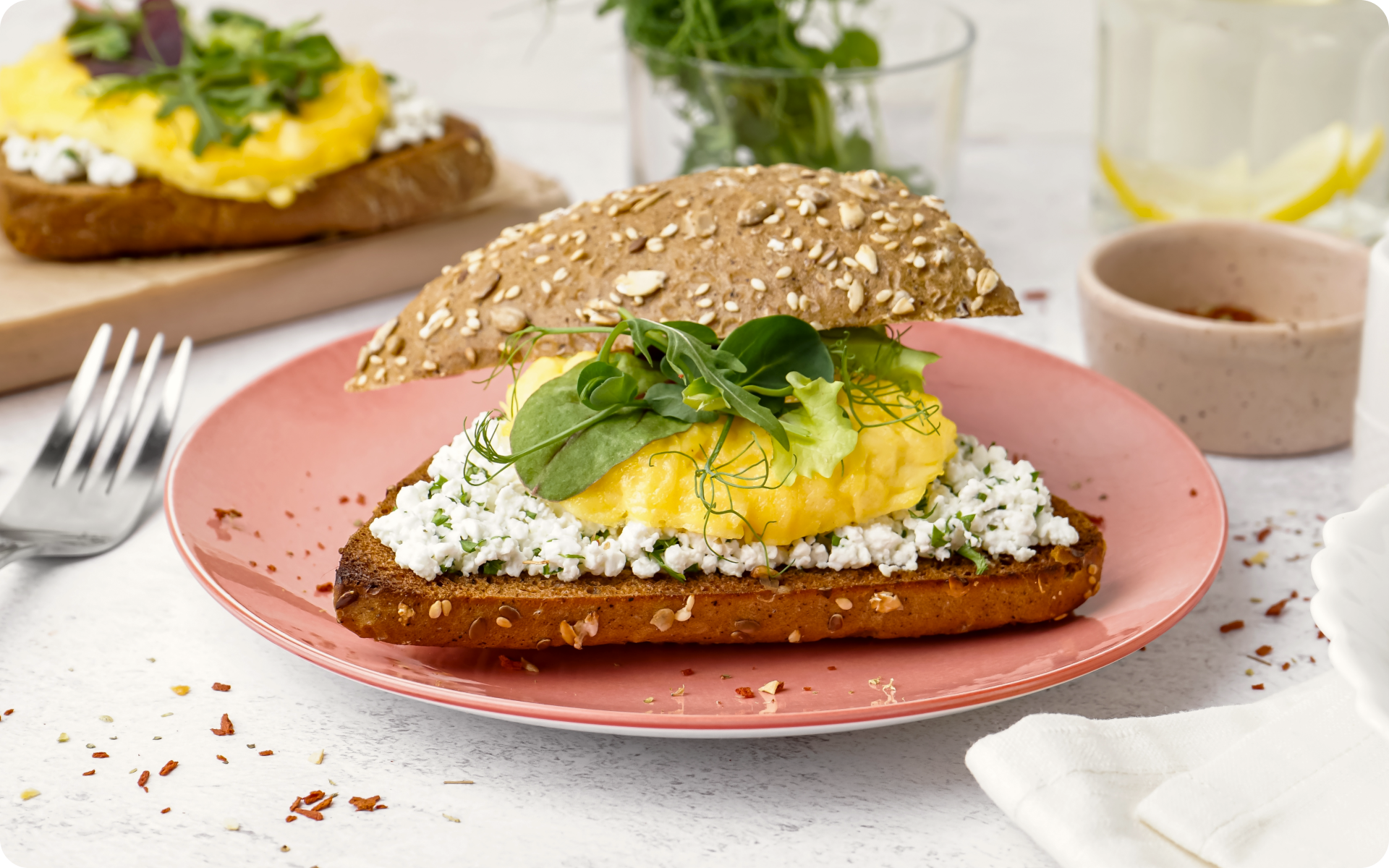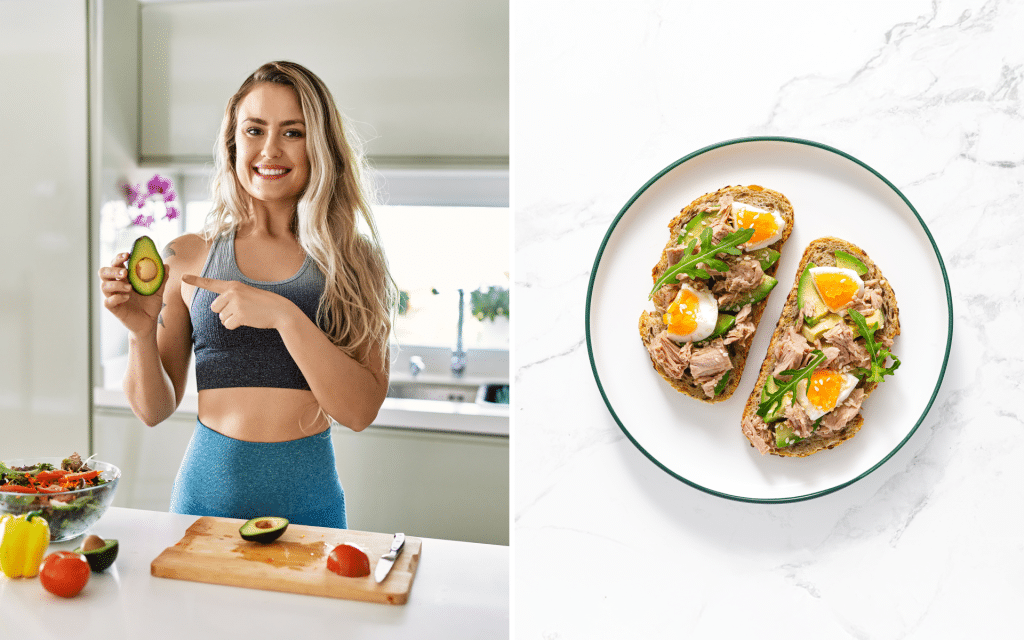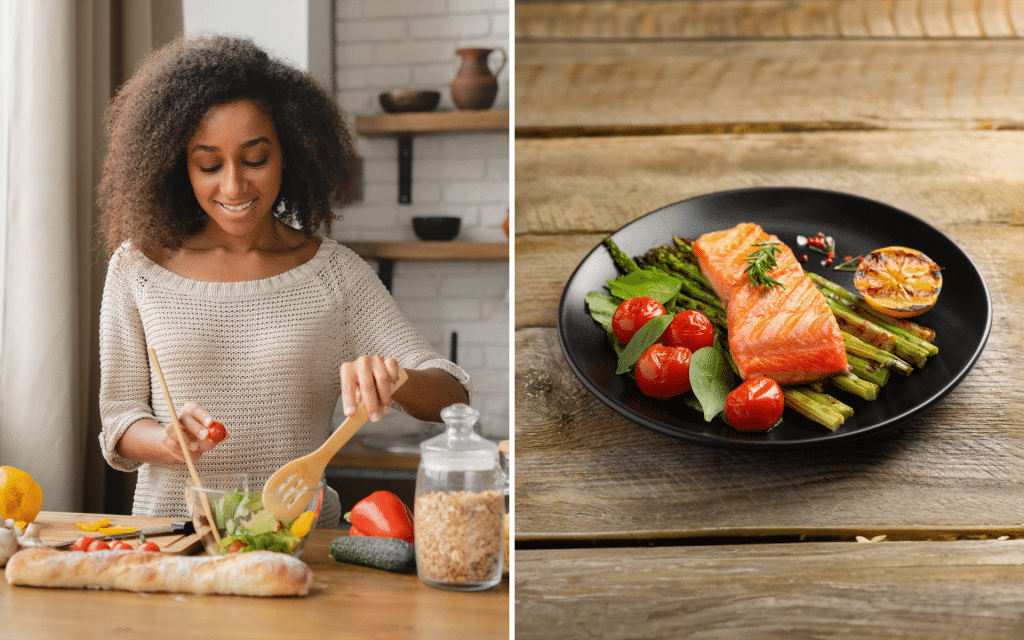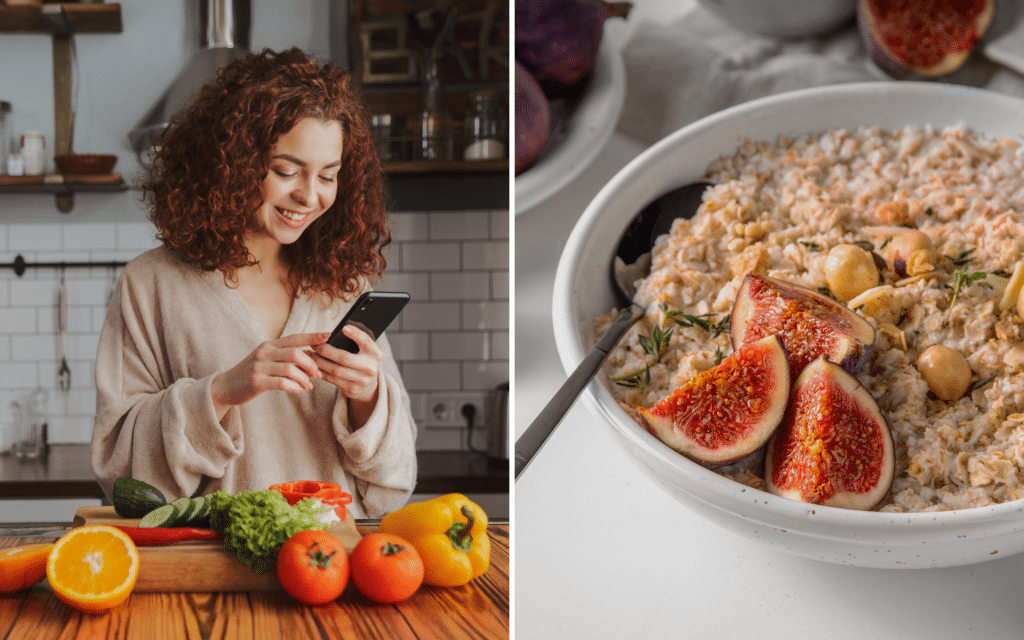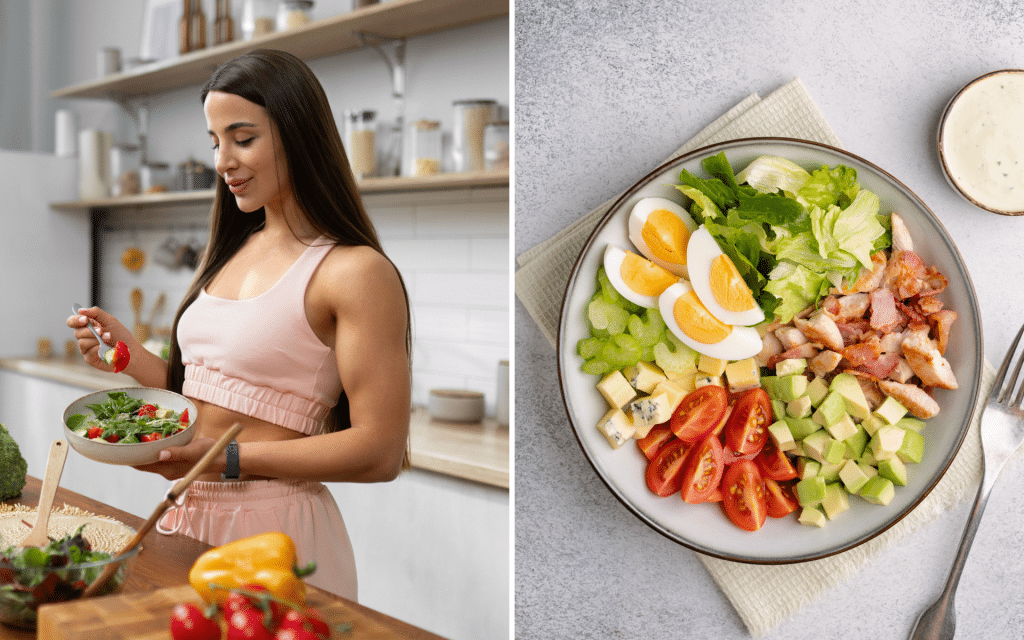A high-protein meal plan is a game-changer for anyone who is looking to boost muscle growth and recovery. Protein serves as the building block for muscle repair (1), while a balanced intake of carbs and healthy fats provides the energy your body needs to push through tough workouts (2).
Beyond just eating enough protein, there are several other factors to consider when creating a high-protein meal plan for muscle gain. In this guide, we’ll discuss the dos and don’ts of designing an effective muscle-building diet.
What Makes Muscles Grow Faster?
When we talk about building muscle, we’re not just talking about lifting weights. There’s a fascinating science behind how muscles grow, adapt, and get stronger. Understanding that science is the key to faster, more efficient progress in the gym.
Muscle growth, or hypertrophy, happens when muscle fibers get bigger after being stressed by exercise and then recovering (3). It’s not magic. It’s biology combined with smart training and nutrition strategies.
Here’s what you need to know to help your muscles grow faster.
1. Consistent Resistance Training
The first rule is a no-brainer. For muscles to grow, they need a signal that tells them they’re needed. This signal comes from resistance training (4). Whether it’s weights, bands, bodyweight exercises, or machines, what matters is how you challenge your muscles.
Key Training Principles:
- Progressive Overload: Gradually increase the weight, reps, or intensity. This continuous challenge forces muscles to adapt (5).
- Repetition Range: Studies have suggested that lifting in a moderate rep range (8-12 reps per set) produces the best outcomes for hypertrophy (6).
- Quality Over Quantity: Focus on proper form. Poor technique increases injury risk and reduces the effectiveness of your workout.
Your muscles adapt to training by increasing in size and strength, but this only happens if they get enough rest and fuel to recover. This is where nutrition comes in.
2. Protein Is Your Muscle’s Best Friend
Muscles are made mostly of water and protein (7, 8). After training, your muscle fibers are damaged and need protein to repair and grow back stronger. This is where protein synthesis comes in. It’s the process by which your body builds new proteins.
BetterMe is your fast-track ticket to long-lasting weight loss! Tailor your fitness journey and maximize your results with just a couple of swipes!
How Much Protein Do You Need?
Research suggests that 1.6 to 2.2 grams of protein per kilogram of body weight per day may be optimal for muscle growth (9). If you weigh 70kg, it’s 112-154 grams of protein daily.
When to Eat Protein
Timing also matters. Spreading your protein intake evenly throughout the day is believed to work best. For example:
- 30g at breakfast, lunch, and dinner, plus another protein-rich snack post-workout.
Studies highlight that eating protein within 1-5 hours after training may help maximize recovery and growth, but that getting enough protein during the next 5-72 hours is also important (10).
High-Quality Protein Sources:
- Animal-based proteins such as chicken, beef, seafood, eggs, and dairy are rich in essential amino acids (11).
- If you’re plant-based, combine options such as beans, lentils, tofu, or quinoa to ensure you’re getting all the essential amino acids.
- Even if you do eat meat, it’s ideal to include a variety of both animal- and plant-based protein sources for optimal nutrition.
Our previous articles cover everything you need to know about a low-calorie high-protein and low-carb high-protein meal plans.
3. Leucine Is a Key Amino Acid
One amino acid deserves special attention. Leucine is critical for turning on muscle protein synthesis (12). Think of it as the “on” switch for muscle repair and growth.
Whey protein is particularly high in leucine (13), which makes it a fantastic post-workout option. If you’re plant-based, you can still meet your leucine needs by consuming larger amounts of diverse plant protein foods or supplements.
A meal with 2-3 grams of leucine (roughly 20-30 grams of most high-quality proteins) is probably enough to maximize protein synthesis after a workout.
4. Carbohydrates Fuel Your Sessions
Carbs aren’t just about immediate energy. After exercise, your body’s glycogen stores (muscle energy reserves) are depleted. If glycogen stays low, your training intensity suffers, and so does your recovery (14).
Best Practices for Carbohydrate Timing:
- Before Training: Eating carbs ensures you have the energy to perform. Think oatmeal or fruit.
- After Training: Post-workout carbs help replenish glycogen. Aim for 1.2g of carbs per kg of body weight, per hour if you’re really depleted, such as after a long run or intense training session. High-glycemic carbs like rice, potatoes, or even a banana post-workout work well (15).
Carbs also play a teamwork role. When paired with protein, carbs help drive amino acids into muscle cells for repair.
5. Energy Balance Is Key
Your total calorie intake matters. To grow muscle, your body must be in a positive energy balance, which means you consume slightly more calories than you burn (16).
How Much of a Surplus?
- A modest surplus of 10-15% above your maintenance calories works well to encourage muscle growth while minimizing fat gain.
Snack on nutrient-dense foods such as nuts, avocados, dairy, and whole grains to fuel your body without overdoing ultra-processed “junk” foods.
6. The Role of Fats
Fats play several roles in optimizing muscle growth. They support hormonal health (17), including healthy testosterone levels, which are essential for muscle repair (18).
Macronutrient Guidelines:
- 20-35% of your daily calories should come from fats, but you may need to stick closer to 20% to leave enough room for the extra protein and carbohydrates.
- Focus on healthy fats such as fatty fish (loaded with omega-3s), nuts, and olive oil.
Avoid extremes. A fat-free diet may have a negative impact on testosterone levels, while excessive fat can hurt overall diet balance and recovery.
7. The Power of Omega-3 Fatty Acids
Omega-3s, primarily found in fish such as salmon, may help reduce muscle inflammation and improve the body’s ability to repair itself. These fatty acids may also boost muscle protein synthesis, particularly in older individuals (19).
If fish isn’t a staple in your diet, consider a quality omega-3 supplement that is rich in DHA and EPA.
8. Rest and Recovery Matter
Muscle growth doesn’t happen while you’re lifting weights. It happens during recovery (20). Here’s what to prioritize:
- Sleep: Aim for 7-9 hours per night. Sleep is when your body releases growth hormones and repairs tissue.
- Rest Days: Alternate intense training days with lighter sessions or full rest. Overtraining stalls progress (21).
- Hydration: Drink water consistently to support recovery and digestion.
9. The Importance of Consistency
No single hack or shortcut guarantees fast muscle growth. It’s the sum of many small, consistent habits over time. A well-structured workout plan, balanced nutrition, and enough recovery all play their part.
Takeaway Checklist for Faster Muscle Growth
- Train with progressive overload.
- Eat 1.6-2.2g of protein per kg of body weight daily.
- Consistently eat enough carbohydrates and protein for peak recovery.
- Maintain a slight calorie surplus for muscle gain.
- Incorporate omega-3s and healthy fats in your diet.
- Prioritize sleep and manage stress.
Remember, your body adapts over weeks and months, not days. Stick to the process, and your hard work will translate into real, lasting muscle growth.
Read more: High-Protein Meal Planning for Beginners: The Ultimate Guide
Which Food Is Highest in Protein?
Protein is the powerhouse macronutrient when it comes to muscle growth, recovery, and overall health. However, not all protein sources are created equal. Some foods are exceptionally high in protein, offering more bang for your calorie buck. Below, we’ll explore the highest-protein foods, covering both animal-based and plant-based options.
Animal-Based Protein Sources
Animal proteins are often considered “complete proteins” as they contain all nine essential amino acids your body can’t produce on its own. These are the “heavyweights” in the protein world.
- Chicken Breast (31 grams of protein per 100 grams) – It’s lean, which means it has minimal fat, making it ideal for muscle gain without unnecessary calories. Grilled, baked, or stir-fried, it’s a versatile staple.
- Egg Whites (11 grams per 3 egg whites (100 grams)) – Egg whites are virtually pure protein with hardly any fat or calories. However, the yolks also contain protein and some other important nutrients, so you may not want to skip them altogether. A whole egg contains about 6 grams of protein.
- Lean Beef (26 grams per 100 grams) – Packed with iron and zinc, beef supports healthy oxygen transport and immunity. Choose lean cuts like sirloin to keep fat in check.
- Tuna (~25 grams of protein per 100 grams, canned in water) – Tuna is incredibly dense in protein and low in fat.
- Salmon (~20-22 grams of protein per 100 grams, cooked) – Salmon adds omega-3 fats for better heart health and reduced inflammation.
- Low-Fat Greek Yogurt (~10 grams of protein per 100 grams) – Greek yogurt isn’t just a protein source, it’s also high in calcium, which is essential for bone health.
- Cottage Cheese (~11 grams of protein per 100 grams) – It’s also rich in casein, a slow-digesting protein, which makes it ideal for sustaining muscle repair overnight.
Plant-Based Protein Sources
For those who are following a plant-based diet, there are plenty of high-protein options. While many plant proteins are “incomplete” (missing some essential amino acids), combining different sources can help you get a complete amino acid profile.
- Lentils (~9 grams of protein per 100 grams, cooked) – Full of fiber, lentils support digestion while delivering a solid protein punch. They’re versatile for curries, soups, and salads.
- Quinoa (~8 grams of protein per 100 grams, cooked) – Unlike most grains, quinoa is a complete protein on its own. It’s also loaded with magnesium and antioxidants.
- Firm Tofu (~10 grams of protein per 100 grams) – This soy-based protein is low in calories and adapts to any flavor profile, which makes it a brilliant option for stir-fries and salads.
- Chickpeas (Garbanzo Beans) (~7.3 grams of protein per 100 grams, cooked) – They’re not just protein-rich but also packed with fiber, which keeps you fuller longer. Think hummus, roasted chickpeas, or curries.
- Edamame (Soybeans) (~11 grams of protein per 100 grams, cooked) – Edamame is a plant protein powerhouse with a complete amino acid profile. Makes for a quick and healthy snack.
- Tempeh (~19 grams of protein per 100 grams) – Another soy-based source, tempeh is dense, chewy, and loaded with nutrients and probiotics.
- Spirulina (~57 grams of protein per 100 grams, powdered form) – This blue-green algae packs a huge protein punch and is also high in vitamins such as B12, although it’s typically consumed in smaller amounts as a supplement.
Honorable Mentions
- Nuts and Seeds (e.g. almonds, chia seeds, and sunflower seeds): High in healthy fats and offer ~5-8 grams of protein per 30 grams.
- Peanuts/Peanut Butter ~8 grams per 2 tablespoons.
- Whole Grains such as oats and brown rice provide ~5 grams of protein per 100 grams.
Ready to fuel your body the paleo way? Discover our top high-protein paleo meals today!
Which Protein Is Best for Muscle Gain?
The best protein for muscle growth depends on your dietary preferences.
Here’s how they measure up:
| Category | Animal-Based | Plant-Based |
|---|---|---|
| Protein quality | Complete and excellent digestibility. | Often incomplete but combinable. |
| Leucine content | High in sources such as whey and meat. | Moderate; requires larger servings. |
| Dietary flexibility | May not be suitable for vegans or vegetarians. | Perfect for plant-based and flexible diets. |
| Nutrients | Often rich in iron and B12. | High in fiber and antioxidants. |
You should consider these factors when choosing a protein source:
- Complete Proteins: These contain all nine essential amino acids (EAAs) your body can’t produce on its own.
- Leucine Content: Leucine is the amino acid that flips the “growth switch” in your muscles by activating muscle protein synthesis (MPS).
- Digestibility: High-quality proteins are easy for your body to absorb and utilize. The digestible indispensable amino acid score (DIAAS) is one way to measure this.
- Timing: Consuming protein after workouts is critical for recovery and growth. A fast-digesting protein such as whey is ideal post-exercise.
Whichever you choose, make sure you’re getting complete amino acids, the choice fits into your daily calorie and macro goals, and is aligned with your personal taste and ethics. An optimal diet will include a variety of different protein sources.
Is 200g of Protein Too Much for Muscle Gain?
For most people, protein intakes beyond ~2.2g/kg/day (or about 150-200g depending on body size) offer diminishing returns. However, 200g of protein isn’t automatically “too much” if it aligns with your weight, activity levels, and goals.
The answer depends on a few key factors.
1. Protein Needs Are Personal
Your protein requirements aren’t the same as your gym buddy’s. Factors such as body weight, training volume, and goals all come into play.
Here’s a rule of thumb:
- For muscle gain, research suggests consuming 1.6 to 2.2 grams of protein per kilogram of body weight each day (9).
- If you weigh 75kg (165 lbs), you’d need 120-165g of protein daily.
- If you weigh 100kg (220 lbs), your protein target could go up to 220g per day.
If you’re heavier, highly active, or aiming for serious muscle mass, 200g may be reasonable. However, for someone smaller or less active, it could be excessive.
2. Does Protein Have an Upper Limit?
There’s no clear-cut “maximum” safe amount of protein, but your body can only use so much for muscle repair and growth. The rest? It’s either oxidized for energy, stored as fat, or excreted through waste.
On training days, your body may need more protein to repair damaged muscles. However, consuming more than your body requires doesn’t mean you’ll build extra muscle. Protein won’t add mass without the right stimulus (e.g. consistent resistance training).
Some studies have tested intakes as high as 3.0-4.0g/kg/day in athletes without health issues. For most people, though, that’s unnecessary.
BetterMe: Health Coaching app helps you achieve your body goals with ease and efficiency by helping to choose proper meal plans and effective workouts. Start using our app and you will see good results in a short time.
3. Are There Risks to Eating Too Much Protein?
For healthy individuals, research has shown that high-protein diets are generally safe. The idea that too much protein harms your kidneys has been largely debunked unless you have pre-existing kidney issues or certain risk factors.
However, extreme intakes (well beyond your needs) may:
- Displace important nutrients (e.g. fiber, healthy fats, carbs).
- Lead to calorie overload, resulting in fat gain.
- Feel heavy on digestion, particularly if your other macronutrients fall short.
4. What Does 200g of Protein Look Like?
Reaching 200g of protein takes effort. Here’s an example breakdown:
- 1 cup oatmeal (6 g protein) with 2 tbsp peanut butter (8 g protein)
- 2 eggs (12g protein).
- 1 protein shake (~30g protein).
- 1 can of tuna (26 g protein).
- 1 cup of lentils (18g protein).
- 1 cup of Greek yogurt (17 g protein) with 3 tbsp hemp seeds (10 g protein).
- 6 oz chicken breast (52 g protein).
- 3.5 oz high protein (legume-based) pasta (25 g protein)
Who Might Need 200g of Protein?
- Heavier individuals with significant lean mass.
- Bodybuilders or athletes with intense training schedules.
- Those with high baseline energy needs who are in a caloric deficit and trying to preserve lean muscle. (Higher protein helps limit muscle loss in caloric deficits.)
Who Doesn’t Need 200g of Protein?
- Someone who weighs less than 90kg (198 lbs) who doesn’t train intensely daily.
- Beginners to resistance training, where smaller protein increases are enough.
How to Calculate Your Needs
If you weigh 70kg (154 lbs), here’s how you’d calculate your protein intake goal:
- Moderate Training (1.6g/kg daily): 70kg x 1.6 = 112g protein/day.
- Intense Training or Cutting (2.2g/kg daily): 70kg x 2.2 = 154g protein/day.
It’s also okay to aim for anywhere between the two.
Read more: Mastering The Basics Of A 1200 Calorie Deficit Meal Plan For Beginners
What Is a Balanced High-Protein Meal Plan for Muscle Gain?
For a high-protein meal plan that’s aimed at muscle gain, the macronutrient breakdown typically looks like this:
- Protein: 25-35% of total daily calories. Protein is essential for muscle repair and growth (22), so this percentage ensures you get enough to support your goals.
- Carbohydrates: 50-60% of total daily calories. Carbs are your primary energy source, particularly for intense workouts, and they help fuel muscle recovery (23).
- Fats: 20-25% of total daily calories. Healthy fats support hormone production (such as testosterone) and overall health, which are essential for muscle growth (17).
This breakdown can vary based on individual factors such as body type, activity level, and specific goals. For example, if you’re very active or doing intense weight training, you may lean toward the higher end of the carb range to ensure adequate energy.
To calculate your daily macronutrient grams, you’ll need to know your daily calorie intake goal. If you’re not sure, a common starting point for muscle gain is to consume approximately 15-17 calories per pound of body weight (or 33-37 calories per kilogram).
Below are some meal ideas:
Day 1
Breakfast
- Scrambled eggs with spinach and a slice of whole-grain toast.
- Black coffee or tea.
Lunch
- Grilled chicken salad with mixed greens, cucumbers, farro, and olive oil dressing.
- A small piece of fruit, such as an apple or orange.
Dinner
- Baked salmon with roasted sweet potatoes and steamed broccoli.
- Side of quinoa or rice.
Snacks
- Low-fat Greek yogurt with a handful of nuts or seeds.
- Hard-boiled eggs with baby carrots.
Day 2
Breakfast
- Oatmeal topped with a dollop of peanut butter and chia seeds.
- A side of scrambled egg whites.
Lunch
- Tuna salad wrap using a whole wheat tortilla, lettuce, and sliced tomatoes.
- Pickle or vegetable sticks on the side.
Dinner
- Grilled turkey burgers on a whole wheat bun served with roasted Brussels sprouts and baked zucchini fries.
- Add a dollop of mustard or avocado for flavor.
Snacks
- Cottage cheese with sliced cucumber or bell peppers.
- Protein shake mixed with almond milk and a banana.
Day 3
Breakfast
- Protein smoothie with frozen berries, spinach, whey or plant-based protein powder, and almond milk.
- A small handful of almonds.
Lunch
- Stir-fried tofu or chicken with mixed vegetables (e.g. bell peppers, broccoli, carrots) over brown rice.
- Season with low-sodium soy sauce or spices.
Dinner
- Grilled steak or tempeh served with roasted asparagus and a baked potato.
- Side of sautéed mushrooms for added flavor.
Snacks
- Boiled edamame with a sprinkle of sea salt.
- Low-fat cheese sticks with a few whole-grain crackers.
Yes, rice is good for bulking. It’s a calorie-dense carbohydrate source that helps replenish glycogen stores and provides energy for intense workouts. White rice in particular is often preferred for quick digestion pre- or post-workout. Brown rice is a slower-digesting whole grain that is also great to include in some meals for extra fiber and longer-lasting energy. Dirty bulking involves eating a calorie surplus with little focus on food quality, often consuming high-calorie, low-nutrient foods to gain weight rapidly. While it’s effective for weight gain, it can lead to excessive fat accumulation and potential health issues (24). Guava has the most protein among fruits with approximately 4.2 grams of protein per cup. Other protein-rich fruits include apricots, kiwis, and blackberries, but they contain significantly less protein than other high-protein foods. On average, beginners can gain 1-2 pounds of muscle per month with proper training, nutrition, and rest. Advanced lifters may gain muscle at a slower rate, around 0.5-1 pound per month, due to diminishing returns.Frequently Asked Questions
Is rice good for bulking?
What is dirty bulking?
What fruit has the most protein?
How much muscle can you gain in a month?
The Bottom Line
Building muscle requires more than just hitting the gym – it’s about fueling your body with the right nutrients consistently. This high-protein meal plan provides a strong foundation for muscle gain by combining high-quality protein sources, healthy fats, and nutrient-rich carbs to support recovery and growth. Remember, variety is the key to keeping meals enjoyable and ensuring you get a wide range of nutrients. Adapt this plan to suit your individual needs, preferences, and goals, and pair it with a disciplined workout routine for the best results.
DISCLAIMER:
This article is intended for general informational purposes only and does not serve to address individual circumstances. It is not a substitute for professional advice or help and should not be relied on for making any kind of decision-making. Any action taken as a direct or indirect result of the information in this article is entirely at your own risk and is your sole responsibility.
BetterMe, its content staff, and its medical advisors accept no responsibility for inaccuracies, errors, misstatements, inconsistencies, or omissions and specifically disclaim any liability, loss or risk, personal, professional or otherwise, which may be incurred as a consequence, directly or indirectly, of the use and/or application of any content.
You should always seek the advice of your physician or other qualified health provider with any questions you may have regarding a medical condition or your specific situation. Never disregard professional medical advice or delay seeking it because of BetterMe content. If you suspect or think you may have a medical emergency, call your doctor.
SOURCES:
- Protein for exercise and recovery (2009, pubmed.ncbi.nlm.nih.gov)
- Athletes’ nutritional demands: a narrative review of nutritional requirements (2004, frontiersin.org)
- The Mechanisms of Muscle Hypertrophy and Their Application to Resistance Training (2010, journals.lww.com)
- Maximizing Muscle Hypertrophy: A Systematic Review of Advanced Resistance Training Techniques and Methods (2019, ncbi.nlm.nih.gov)
- Understanding and Using the Overload Principle (2024, issaonline.com)
- Loading Recommendations for Muscle Strength, Hypertrophy, and Local Endurance: A Re-Examination of the Repetition Continuum (2021, ncbi.nlm.nih.gov)
- The Role of Water Homeostasis in Muscle Function and Frailty: A Review (2019, ncbi.nlm.nih.gov)
- Physiology, Skeletal Muscle (2023, ncbi.nlm.nih.gov)
- Recent Perspectives Regarding the Role of Dietary Protein for the Promotion of Muscle Hypertrophy with Resistance Exercise Training (2018, ncbi.nlm.nih.gov)
- Achieving Optimal Post-Exercise Muscle Protein Remodeling in Physically Active Adults through Whole Food Consumption (2018, ncbi.nlm.nih.gov)
- Food proteins from animals and plants: Differences in the nutritional and functional properties (2022, sciencedirect.com)
- The Role of Leucine in the Regulation of Protein Metabolism (2005, sciencedirect.com)
- Whey protein supplementation and muscle mass: current perspectives (2019, tandfonline.com)
- Exercise and Regulation of Carbohydrate Metabolism (2015, ncbi.nlm.nih.gov)
- Fundamentals of glycogen metabolism for coaches and athletes (2018, ncbi.nlm.nih.gov)
- Is an Energy Surplus Required to Maximize Skeletal Muscle Hypertrophy Associated With Resistance Training (2019, frontiersin.org)
- Dietary Fats, Human Nutrition and the Environment: Balance and Sustainability (2022, frontiersin.org)
- Testosterone levels positively linked to muscle mass but not strength in adult males aged 20–59 years: a cross-sectional study (2025, frontiersin.org)
- The Influence of Omega-3 Fatty Acids on Skeletal Muscle Protein Turnover in Health, Disuse, and Disease (2019, frontiersin.org)
- Exploring the Science of Muscle Recovery (n.d., blog.nasm.org)
- Overtraining Syndrome: A Practical Guide (2012, ncbi.nlm.nih.gov)
- Dietary Protein and Muscle Mass: Translating Science to Application and Health Benefit (2019, ncbi.nlm.nih.gov)
- Carbohydrate and Exercise (n.d., pressbooks.calstate.edu)
- How To Clean Bulk – Bulking Up the Healthy Way (n.d., blog.nasm.org)
